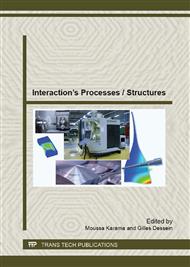[1]
O. Ghouati, J.-C. Gelin, Identification of material parameters directly from metal forming processes, J. Mater. Process. Technol. 80–81 (1998) 560–564.
DOI: 10.1016/s0924-0136(98)00159-9
Google Scholar
[2]
J.S. Chung, S.M. Hwang, Application of a genetic algorithm to process optimal design in non isothermal metal forming, J. Mater. Process. Technol.80–81 (1998) 136–143.
DOI: 10.1016/s0924-0136(98)00209-x
Google Scholar
[3]
X.T. Feng, C. Yang, Genetic evolution of nonlinear material constitutive models, Comput. Methods Appl. Mech. Engrg. 190 (2001) 5957–5973.
DOI: 10.1016/s0045-7825(01)00207-9
Google Scholar
[4]
A. Khalfallah, H. Bel Hadj Salah , A. Dogui Anisotropic parameter identification using inhomogeneous tensile test. European Journal of Mechanics A/Solids 21 (2002) 927–942
DOI: 10.1016/s0997-7538(02)01246-9
Google Scholar
[5]
N. Chakraborti, Genetic algorithms in material design and processing, Int. Mater. Rev. 49 (3–4) (2004) 246–260.
Google Scholar
[6]
H. Naceur, Y.Q. Guo, S. Ben-Elechi Response surface methodology for design of sheet forming parameters to control springback effects. Computers and Structures 84 (2006) 1651–1663
DOI: 10.1016/j.compstruc.2006.04.005
Google Scholar
[7]
M. KocË, T. Altan. An overall review of the tube hydroforming (THF) technology Journal of Materials Processing Technology 108 (2001) 384±393
DOI: 10.1016/s0924-0136(00)00830-x
Google Scholar
[8]
N. Siva, P. Varma, R. Narasimhan, A.A. Luo, A.K. Sachdev, An analysis of localized necking in aluminiumalloy tubes during hydroforming using a continuum damage model, I. J. Mech. Sci. 49 (2007) 200–209
DOI: 10.1016/j.ijmecsci.2006.08.005
Google Scholar
[9]
I.M. Pereiraa, G. Rubimb, O. Acselradc, P.R. Cetlin, Comparison of the experimental and the numerically predicted mechanical damage in the sheet forming of steel, J. Mater. Proc. Tech. 203 (2008) 13–18
DOI: 10.1016/j.jmatprotec.2007.09.083
Google Scholar
[10]
M. Ayadi & al. Experimental and numerical studies of welded tube formability. J. Mat. Sci. Forum 614 (2009) 129–134
Google Scholar
[11]
M. Ayadi & al. Experimental and Numerical Study of Hydroforming Aptitudes of Welded Tubes, International Journal of Mechatronics and Manufacturing Systems Vol.4, No1, 2011, PP 74-94
DOI: 10.1504/ijmms.2011.038001
Google Scholar
[12]
van den Boogaard, A.H., Bolt, P.J., Werkhoven, R.J., 2001. Aluminum sheet forming at elevated temperatures. In: Mori, K.-I. (Ed.), Simulation of Materials Processing: Theory, Methods and Applications. A.A. Balkema, Lisse, p.819–824.
Google Scholar
[13]
van den Boogaard, A.H., 2002. Thermally Enhanced Forming of Aluminum Sheet: Modeling and Experiments. Ponson & Looijen, The Netherlands.
Google Scholar
[14]
anadija, M., Brnic´, J., 2004. Associative coupled thermoplasticity at finite strain with temperature dependent material parameters. Int. J. Plasticity 20 (10), 1851–1874.
DOI: 10.1016/j.ijplas.2003.11.016
Google Scholar
[15]
Abedrabbo, N., Pourboghrat, F., Carsley, J., 2005a. Forming of aluminum alloys at elevated temperatures. Part 2: Numerical modeling and experimental verification. Int. J. Plasticity.
DOI: 10.1016/j.ijplas.2005.03.006
Google Scholar
[16]
Nader Abedrabbo a, Farhang Pourboghrat a,, John Carsley b. Forming of aluminum alloys at elevated temperatures – Part 1: Material characterization, International Journal of Plasticity 22 (2006) 314–341
DOI: 10.1016/j.ijplas.2005.03.005
Google Scholar
[17]
W. Shen & al. An anisotropic damage-based plastic yield criterion and its application to analysis of metal forming process. International Journal of Mechanical Sciences 47 (2005) 1897–(1922)
DOI: 10.1016/j.ijmecsci.2005.07.007
Google Scholar
[18]
H.D. Manesh, A.K. Taheri . Bond strength and formability of an aluminum-clad steel sheet Journal of Alloys and Compounds 361 (2003) 138–143
DOI: 10.1016/s0925-8388(03)00392-x
Google Scholar
[19]
Y. Chino et al. Stretch formability at elevated temperature of a cross-rolled AZ31 Mg alloy sheet with different rolling routes Materials Science and Engineering A 473 (2008) 195–200
DOI: 10.1016/j.msea.2007.05.109
Google Scholar
[20]
U. Reisgen et al. Uni- and bi-axial deformation behavior of laser welded advanced high strength steel sheets Journal of Materials Processing Technology 210 (2010) 2188–2196
DOI: 10.1016/j.jmatprotec.2010.08.003
Google Scholar
[21]
M. Ayadi, M.A Rezgui , A. Cherouat, F. Slimani et T. M. Nasri. Contribution à la modélisation Expérimentale et Numérique des Instabilités Plastiques en Hydroformage des Tôles Minces, Mécanique & Industries Vol.10 (2009) pp : 503-519, EDP Sciences
DOI: 10.1051/meca/2010009
Google Scholar


